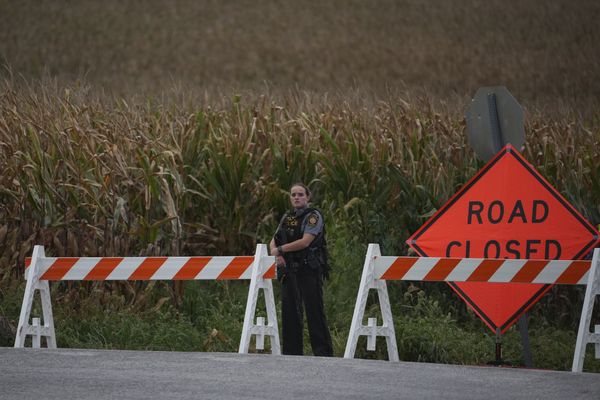
If you’ve ever kayaked down the Chicago River or relaxed along any of the waterways in the area, you may have encountered all sorts of creatures — an enormous snapping turtle, a stray alligator or maybe something that looks a lot like a lobster.
It turns out a lobster-like creature spotted swimming around the city was a red swamp crayfish, and its presence in Chicago waterways is a warning sign.
According to one ecologist, that particular crayfish species currently inhabiting the Chicago River could be second only to Asian Carp in terms of its invasiveness and potential to wreak havoc on local ecosystems, given their well-documented impact around the world.
The North Branch of the Chicago River around West Foster Avenue is among the areas where a lot of red swamp crayfish hang out.

Loyola University freshwater ecologist Reuben Keller and lab manager Rachel Egly go out on the water regularly to set traps. On a sunny weekday afternoon, Egly pulls up a cage from the water to find two red swamp crayfish that are less than six inches long from claw to tail.
These creatures are bright red with two long antennae, pincer claws and eight legs. They look like lobsters, but much smaller. American lobsters can get up to about two-feet long while red swamp crayfish max out at about five inches.
Unlike calico crayfish that are native to the Chicago area, red swamp crayfish come from the southern U.S. They’re a big part of the food culture in Louisiana, where fishermen have been harvesting them commercially since the late 1800s. But it’s not recommended to eat the ones found in the Chicago River because their densest populations are found about a mile downstream from a sewage treatment plant.
There are several theories on how the red swamp crayfish got to Chicago. The crustaceans could’ve been used as bait; some may have come from pet shops or a few may have escaped a pending boil. But Keller believes the likeliest culprits are local elementary schools, where they make “a great classroom pet.”
At the end of the school year, Keller thinks some classes may have turned the crayfish loose in the river without realizing these things are known as one of the most invasive species in the world.
“The red swamp crayfish is a burrowing species,” Keller said. “In some parts of the world, it will weaken levees and lead to levee failure and flooding.”
Keller said that if Asian Carp are a code red issue for the Illinois River, he predicts that the red swamp crayfish could be just one step below that. He doesn’t know yet the impact the creature has had on the area, but he knows the problems they can cause if things get out of control.
It happened in southeast Wisconsin in 2009. The Wisconsin Department of Natural Resources kept getting calls from residents complaining about crustaceans on their lawns.
Bob Stroess, who enforces Wisconsin’s trade rules for commercial fish and aquatic species, said
“No state, no city, no county can afford the cleanup for these if they expand beyond a small little area,” Stroess said.
Bringing red swamp crayfish into Wisconsin alive is illegal now. That’s also the case for Minnesota, Michigan and Illinois.
Dead, frozen red swamp crayfish are allowed in Illinois. But having, importing or selling live crayfish in Illinois carry penalties ranging from a petty offense to a Class 3 felony. Fines go from $195 to tens of thousands of dollars.
Still, the state’s work doesn’t reduce the population that’s already here. That’s why part of the work Keller and his team are doing involves killing red swamp crayfish.
For now, his lab currently has about 200 traps in the water, which are emptied out twice a week throughout the summer.
“Our first priority is to figure out how to reduce the population because based on everything we know, there’s really good reason to believe that they are having large impacts here, where they’re established,” he said.
But the most difficult part of reducing the population is that Keller and his lab are the only ones doing this taxing work. They’re just one lab and they’re outnumbered by the crayfish.
The least the public can do is not bring live crayfish around these parts. If you spot one, think twice before you kill one yourself: It takes some training to properly identify the red swamp crayfish (while the adults are bright red, the juveniles look similar to some native crayfish). The safest option would be to contact the Illinois Conservation Police.
You can learn more about red swamp crayfish research at the Keller Lab website.
Laura Pavin is a journalist living in the greater Chicago area.







